The evolution of racing games, part 1
Many of us experienced in our experience most of the evolution of racing games, starting with Atari and Dendy and ending with the latest Need for Speed. In this article we will look at the first steps of game developers towards creating the best car simulators.
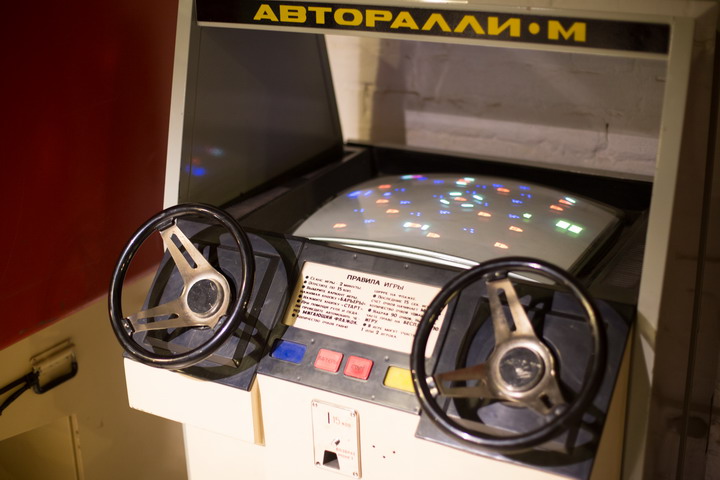
The history of car simulators began in clubs with slot machines. It was there that such characteristics of modern games originated, such as the view from the cockpit or from above behind, the game together and against the computer, the tactile response in case of accidents.
')
We should also say about the screens. Images on the screen in games similar to modern car simulators were originally projected from plastic substrates. Later screens in most racing machines were replaced by television. Such devices were called in the USSR - “gaming television machines”. For example, in Avtoralli-M, the TV lay horizontally inside the device. Let's look at the evolution of games through specific examples.
American Atari had an impact on the birth of the entire video game industry. The company was founded in 1972, its first product was Pong. This gaming machine consisted of a black and white TV, equipment for the game and coin acceptor. The second after the Pong arcade machine gun from Atari was the space race machine - Space Race. To win, you had to go through asteroids without losing the ship. The game provided for a single player mode or simultaneous fight of two players. The joystick was controlled in the same plane: up and down. In the analog game from the company Taito, Astro Race, the joystick had four positions: the opportunity to move in four directions.
Space Race Gameplay
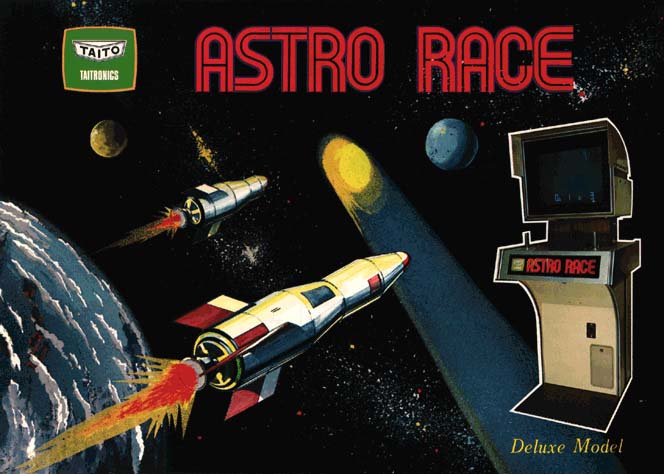
Advertisement Astro Race
Taito's Speed Race machines produced about seven thousand units. It was one of the most popular racing machines at the time - although the competition was not very high. The car turned in the same plane. To the right of the steering wheel is the gear shift lever, and under the foot is the gas button. In the Australian version, the lever was placed on the left.
The goal is not to crash into other cars during the race. Over time, the speed increases, and the competition becomes more.

Advertising for the European market
The game Gran Trak 10 from Atari, released in 1974, was a race on the track with a top view. The car looked more like a square than a car.

If in the Speed Race it was necessary to go around rivals, then in Crashing Race to earn points you had to crash into them. This 1976 game of release continued the line of racing arcade machines from Taito. The system was designed for two players.

All previous games were monochrome, the graphics in them corresponded to the capabilities of computers of that time. To make the image more realistic, colorful and vivid, Atari and Namco used a different approach when developing the F-1 submachine gun in 1976.
In the video below you can see perfectly how the display of the gaming machine is arranged. From the inside, images of various elements were projected onto the transparent screen - the road itself, the walls, bushes, and advertising posters. In an accident, the lights were turned on under a plastic backing with an image of an explosion, so that the fire would occupy the entire screen. The car turns in the same plane at the bottom of the machine, and the player's actions simultaneously affect another machine - it drives along the road projected on the screen.
The view in the game was from the third person, from above behind the car, which is already bringing us closer to the modern versions of car simulators.
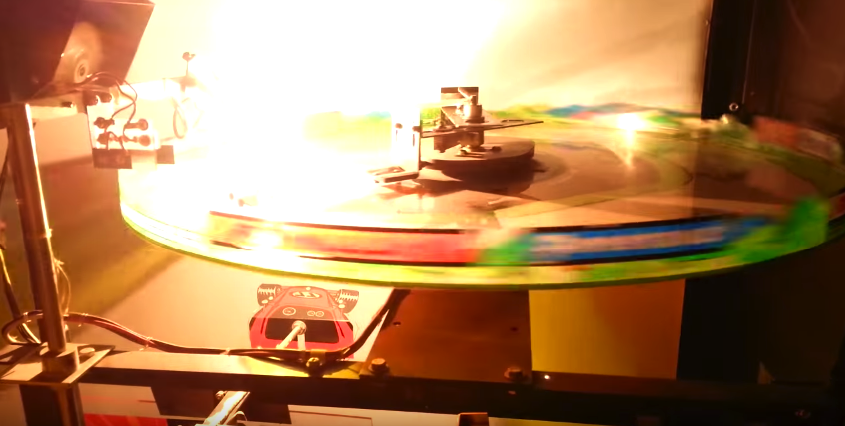
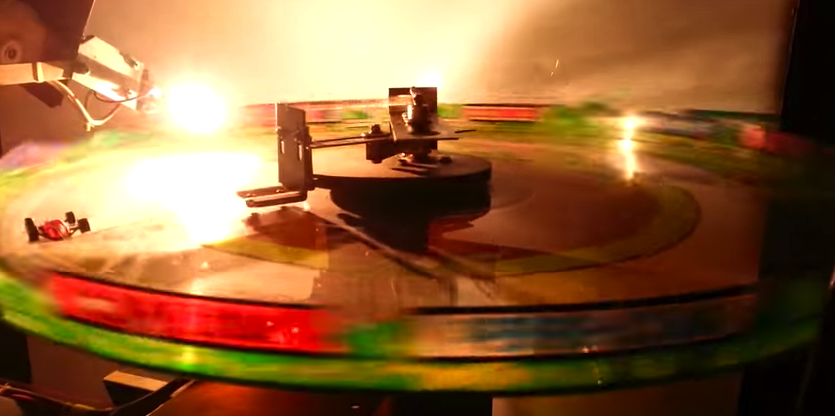
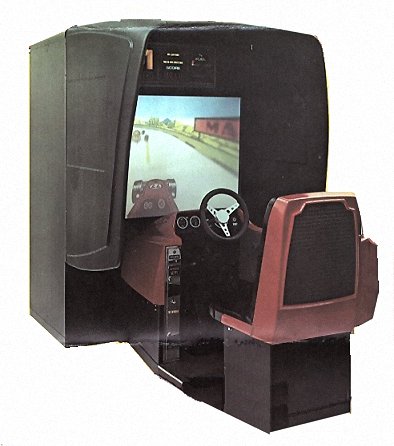
People always need a variety, they get used to the same races. Atari in 1978 decided that a good idea would not drive a Formula 1 car, but a fire engine. It was possible to play together, with one player sitting in the chair, the second - managed by the second helm, standing behind the first player. Management was carried out in all directions. It was necessary to go around the puddles of engine oil and avoid collisions with the curb, as well as monitor the level of fuel.


Another monochrome automatic - Night Racer with a view from the cockpit.
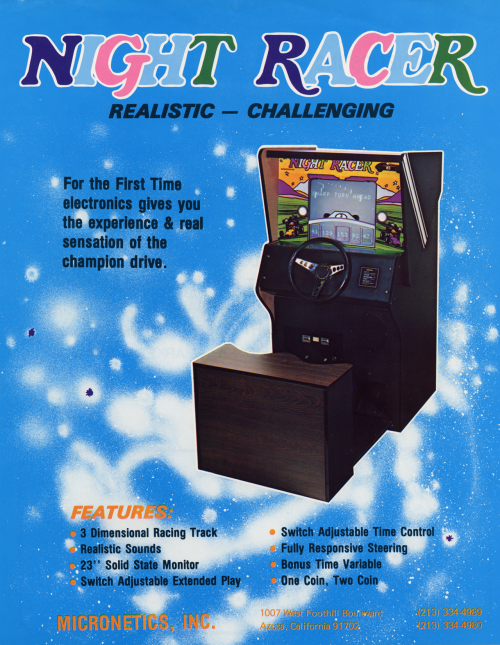
Where are the cars, there are motorcycles: Sega in 1976 began selling the FONZ gaming machine with motorcycle races. It was necessary to evade other motorcycles and other obstacles. During the collisions, the steering wheel vibrated - the usual tactile response appeared for us today.


Gaming machines from other countries were brought to the USSR, brought to military factories, and then, in parallel with military equipment, they collected such toys for clubs. This allowed the plan to produce civilian equipment.
One of the examples of Soviet racing automata is Avtoralli-M 1981 of release. It was possible to play together. Feel the atmosphere here . This machine is a television. It has a built-in screen on the radial tube.
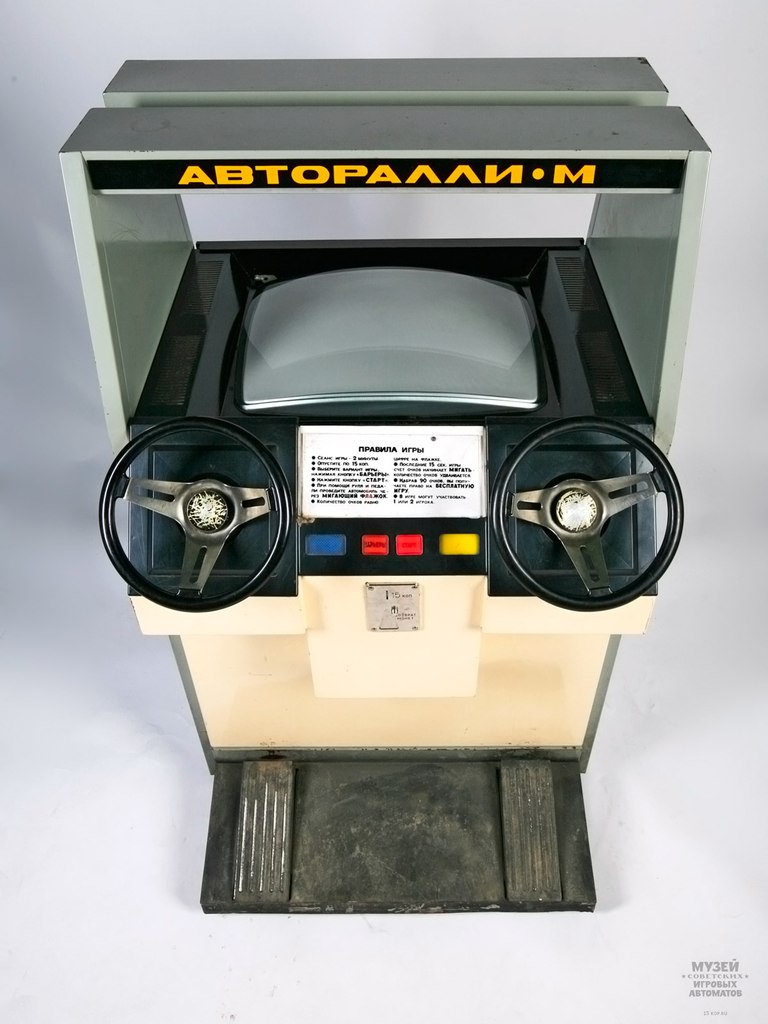
In the game Road Champion, rival cars stopped being a common obstacle. Here they were already controlled by a computer. It was necessary to reach the finish line first.
Sega in the game Monaco GP showed color graphics.
But why project plastic images or use computer graphics that are not very beautiful at that time, if you can use a regular videotape? This question was asked by the developers from Kasco, creating the driver-racing action The Driver. In the machine was installed 16-mm film. This is reminiscent of the first examples of virtual reality , namely the 1956 Sensorama helmet.
In The Driver, the player, using the steering wheel and pedals, repeated the actions of the car from the film that is shown on the screen.
The reference game that spawned many imitators was the 1982 Atari Pole Position. Here a bird's-eye view was used, which has become primarily used for future racing.
There was only one track in the game - Fuji Speedway in Japan, where Formula 1 championships were held. This added to the gameplay of realism.

Another Atari racing game was Indy 800. The most interesting in this slot machine is multiplayer - not two players fought on the track, but up to eight people at once.
The history of racing games began in clubs, but in the same 1970s racing games became available for home use to first-generation game console owners.
Complete with the first Magnavox Odissey went skiing. For this console, the game was a lining on the TV. With the help of cartridges with a certain set of jumpers, the necessary game was turned on, and on the TV, under a plastic overlay, balls started to fly and fly, pointing to the desired part of the screen.


In a series of game consoles company Telstar was a modification of the Arcade. Various elements of control were added to the triangular case on each side, among which was a steering wheel with a gear shift knob. And the corresponding game was.

Another way to play home racing was the Game Racing 112 racing simulator - a color prefix to the TV from Nintendo , released in 1978. Used to control the steering wheel, in the console was also a gear lever. And awesome graphics! Below is a video gameplay.

One of the most popular gaming consoles in the 1970s and 1980s was the Atari 2600. In total, more than forty million copies were sold. For the console even made wireless controllers. Atari movies with Jack Black and Pele look in the history of game consoles in advertising, part 1 .

One of the most popular games at the start of sales of the Atari 2600 console in 1977 was the Indy 500 - ring races. It was essentially a version of the Indy 800 from the gaming machine, but adapted for home televisions and two joysticks instead of eight steering wheels.

Need for Speed of that time became Street Racer for the Atari 2600.
In 1983, the game from the arcade machine from Namco and Atari - Pole Position - was ported to the prefix 2600. Everything was there - back view from above, computer-controlled rivals, pseudo-3D, beautiful landscapes and high speeds. The game was then ported to many other game consoles.
One of my favorite game modes is drift, especially for Need For Speed: Underground. Long before the creation of this game, braking before turning and controlled drifts in races were added by the TX-1 developers from Tatsumi. In this race there were various tracks, the game was played against rivals, it was important to explode less on the road from collisions. A fork in the game was added with the ability to choose a turn and vibration in the steering wheel.
In the 1970s, personal computers began to appear, and in the 1980s, their prices became more affordable. In 1981, for the BBC, the BBC Micro computer was designed on a MOS Technology 6502A processor, costing from 235 British pounds. For this computer have developed another racing game based on the "Formula 3" - REVS. The highlight was realistic at that time control of the car.
The creators of games for consoles and automata continued to work on the realistic process. One of the iconic machines became the Hang-On by Sega. The motorcycle was controlled by tilting the hull - that is, the joystick was made in the form of a full-sized racing vehicle.
It is worth noting another picture: Sega used a 16-bit processor and pseudo-three-dimensional graphics.
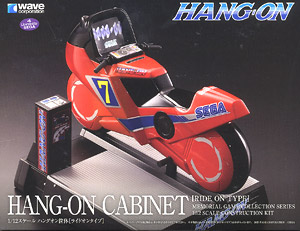
One of the most beautiful games was Out Run 1986 autosimulator. In addition to the driver of the car Ferrari Testarossa and his girlfriend, there were other people around here - the fans. Plus, palm trees, blue sky, sandy beach, mountains, weather changes are very atmospheric.
In the arcade machine control used steering wheel, gear lever, gas pedal and brake. The player had the opportunity to choose the music, as well as the route - there was a fork in which it was possible to turn in any direction.
The game was ported to different game systems and computers, sometimes with restrictions — there were no forks in the Commodore 64, and there is no music in the Sinclair ZX Spectrum.


The Square Auto Race Rad Racer for the Nintendo Entertainment System was one of the most commercially successful consoles in the 1980s.
Innovations have touched both gameplay and graphics. In the gameplay added race through check-points with a time limit, and for three-dimensional graphics provided stereo glasses and a special mode. It was one of the first steps towards virtual reality in racing games.
Below is the gameplay. On the car selection screen, I realized that I had played Rad Racer as a child. Sorry, no 3D glasses.

In the 1970s and 1980s, the basic characteristics and makings of the future possibilities of video games related to racing took shape. Important for the developers - or, better, for the players - was the realistic gameplay. This applies not only to the image on the screen, additional elements, landscapes, drawing cars, but also the management itself, the physics in the game. The technical capabilities at that time were far from ideal, but we see attempts to create something close to real races in the very first steps.
In games there was a semblance of three-dimensional graphics, a tactile response at the helms of slot machines, almost real steering wheels and pedals. In one of the latest examples of the article, I pointed out the stereo glasses for the Nintendo Entertainment System - this Japanese corporation added important innovations to the gaming industry many times, and once again made its contribution, although it was ahead of its time.
Races were conducted in various modes. These include passing checkpoints for a while, avoiding obstacles, conditionally free movement on the map, racing with running out of fuel, the need to specifically crash into opponents. In addition to car developers used fire engines, motorcycles. And even skis.
Important availability of computer games. Arcade machines were popular for a long time, although in the 1970s it was possible to play at home. But it might have been more convenient for people to throw tokens than to spend immediately a tangible amount on a console or even more so a computer. And the realism in the first stages was much higher in the arcade machine than in the same Atari 2600. Time passed, the production of automata gradually decreased, and as a result, the games migrated to home TVs and computers. How the graphics changed, what games were popular in the late 1980s and in the 1990s, we'll talk in the next article.


The history of car simulators began in clubs with slot machines. It was there that such characteristics of modern games originated, such as the view from the cockpit or from above behind, the game together and against the computer, the tactile response in case of accidents.
')
We should also say about the screens. Images on the screen in games similar to modern car simulators were originally projected from plastic substrates. Later screens in most racing machines were replaced by television. Such devices were called in the USSR - “gaming television machines”. For example, in Avtoralli-M, the TV lay horizontally inside the device. Let's look at the evolution of games through specific examples.
American Atari had an impact on the birth of the entire video game industry. The company was founded in 1972, its first product was Pong. This gaming machine consisted of a black and white TV, equipment for the game and coin acceptor. The second after the Pong arcade machine gun from Atari was the space race machine - Space Race. To win, you had to go through asteroids without losing the ship. The game provided for a single player mode or simultaneous fight of two players. The joystick was controlled in the same plane: up and down. In the analog game from the company Taito, Astro Race, the joystick had four positions: the opportunity to move in four directions.
Space Race Gameplay

Advertisement Astro Race
Taito's Speed Race machines produced about seven thousand units. It was one of the most popular racing machines at the time - although the competition was not very high. The car turned in the same plane. To the right of the steering wheel is the gear shift lever, and under the foot is the gas button. In the Australian version, the lever was placed on the left.
The goal is not to crash into other cars during the race. Over time, the speed increases, and the competition becomes more.

Advertising for the European market
The game Gran Trak 10 from Atari, released in 1974, was a race on the track with a top view. The car looked more like a square than a car.

If in the Speed Race it was necessary to go around rivals, then in Crashing Race to earn points you had to crash into them. This 1976 game of release continued the line of racing arcade machines from Taito. The system was designed for two players.

All previous games were monochrome, the graphics in them corresponded to the capabilities of computers of that time. To make the image more realistic, colorful and vivid, Atari and Namco used a different approach when developing the F-1 submachine gun in 1976.
In the video below you can see perfectly how the display of the gaming machine is arranged. From the inside, images of various elements were projected onto the transparent screen - the road itself, the walls, bushes, and advertising posters. In an accident, the lights were turned on under a plastic backing with an image of an explosion, so that the fire would occupy the entire screen. The car turns in the same plane at the bottom of the machine, and the player's actions simultaneously affect another machine - it drives along the road projected on the screen.
The view in the game was from the third person, from above behind the car, which is already bringing us closer to the modern versions of car simulators.



People always need a variety, they get used to the same races. Atari in 1978 decided that a good idea would not drive a Formula 1 car, but a fire engine. It was possible to play together, with one player sitting in the chair, the second - managed by the second helm, standing behind the first player. Management was carried out in all directions. It was necessary to go around the puddles of engine oil and avoid collisions with the curb, as well as monitor the level of fuel.


Another monochrome automatic - Night Racer with a view from the cockpit.

Where are the cars, there are motorcycles: Sega in 1976 began selling the FONZ gaming machine with motorcycle races. It was necessary to evade other motorcycles and other obstacles. During the collisions, the steering wheel vibrated - the usual tactile response appeared for us today.


Gaming machines from other countries were brought to the USSR, brought to military factories, and then, in parallel with military equipment, they collected such toys for clubs. This allowed the plan to produce civilian equipment.
One of the examples of Soviet racing automata is Avtoralli-M 1981 of release. It was possible to play together. Feel the atmosphere here . This machine is a television. It has a built-in screen on the radial tube.

In the game Road Champion, rival cars stopped being a common obstacle. Here they were already controlled by a computer. It was necessary to reach the finish line first.
Sega in the game Monaco GP showed color graphics.
But why project plastic images or use computer graphics that are not very beautiful at that time, if you can use a regular videotape? This question was asked by the developers from Kasco, creating the driver-racing action The Driver. In the machine was installed 16-mm film. This is reminiscent of the first examples of virtual reality , namely the 1956 Sensorama helmet.
In The Driver, the player, using the steering wheel and pedals, repeated the actions of the car from the film that is shown on the screen.
The reference game that spawned many imitators was the 1982 Atari Pole Position. Here a bird's-eye view was used, which has become primarily used for future racing.
There was only one track in the game - Fuji Speedway in Japan, where Formula 1 championships were held. This added to the gameplay of realism.

Another Atari racing game was Indy 800. The most interesting in this slot machine is multiplayer - not two players fought on the track, but up to eight people at once.
The history of racing games began in clubs, but in the same 1970s racing games became available for home use to first-generation game console owners.
Complete with the first Magnavox Odissey went skiing. For this console, the game was a lining on the TV. With the help of cartridges with a certain set of jumpers, the necessary game was turned on, and on the TV, under a plastic overlay, balls started to fly and fly, pointing to the desired part of the screen.


In a series of game consoles company Telstar was a modification of the Arcade. Various elements of control were added to the triangular case on each side, among which was a steering wheel with a gear shift knob. And the corresponding game was.

Another way to play home racing was the Game Racing 112 racing simulator - a color prefix to the TV from Nintendo , released in 1978. Used to control the steering wheel, in the console was also a gear lever. And awesome graphics! Below is a video gameplay.

One of the most popular gaming consoles in the 1970s and 1980s was the Atari 2600. In total, more than forty million copies were sold. For the console even made wireless controllers. Atari movies with Jack Black and Pele look in the history of game consoles in advertising, part 1 .

One of the most popular games at the start of sales of the Atari 2600 console in 1977 was the Indy 500 - ring races. It was essentially a version of the Indy 800 from the gaming machine, but adapted for home televisions and two joysticks instead of eight steering wheels.

Need for Speed of that time became Street Racer for the Atari 2600.
In 1983, the game from the arcade machine from Namco and Atari - Pole Position - was ported to the prefix 2600. Everything was there - back view from above, computer-controlled rivals, pseudo-3D, beautiful landscapes and high speeds. The game was then ported to many other game consoles.
One of my favorite game modes is drift, especially for Need For Speed: Underground. Long before the creation of this game, braking before turning and controlled drifts in races were added by the TX-1 developers from Tatsumi. In this race there were various tracks, the game was played against rivals, it was important to explode less on the road from collisions. A fork in the game was added with the ability to choose a turn and vibration in the steering wheel.
In the 1970s, personal computers began to appear, and in the 1980s, their prices became more affordable. In 1981, for the BBC, the BBC Micro computer was designed on a MOS Technology 6502A processor, costing from 235 British pounds. For this computer have developed another racing game based on the "Formula 3" - REVS. The highlight was realistic at that time control of the car.
The creators of games for consoles and automata continued to work on the realistic process. One of the iconic machines became the Hang-On by Sega. The motorcycle was controlled by tilting the hull - that is, the joystick was made in the form of a full-sized racing vehicle.
It is worth noting another picture: Sega used a 16-bit processor and pseudo-three-dimensional graphics.

One of the most beautiful games was Out Run 1986 autosimulator. In addition to the driver of the car Ferrari Testarossa and his girlfriend, there were other people around here - the fans. Plus, palm trees, blue sky, sandy beach, mountains, weather changes are very atmospheric.
In the arcade machine control used steering wheel, gear lever, gas pedal and brake. The player had the opportunity to choose the music, as well as the route - there was a fork in which it was possible to turn in any direction.
The game was ported to different game systems and computers, sometimes with restrictions — there were no forks in the Commodore 64, and there is no music in the Sinclair ZX Spectrum.


The Square Auto Race Rad Racer for the Nintendo Entertainment System was one of the most commercially successful consoles in the 1980s.
Innovations have touched both gameplay and graphics. In the gameplay added race through check-points with a time limit, and for three-dimensional graphics provided stereo glasses and a special mode. It was one of the first steps towards virtual reality in racing games.
Below is the gameplay. On the car selection screen, I realized that I had played Rad Racer as a child. Sorry, no 3D glasses.

In the 1970s and 1980s, the basic characteristics and makings of the future possibilities of video games related to racing took shape. Important for the developers - or, better, for the players - was the realistic gameplay. This applies not only to the image on the screen, additional elements, landscapes, drawing cars, but also the management itself, the physics in the game. The technical capabilities at that time were far from ideal, but we see attempts to create something close to real races in the very first steps.
In games there was a semblance of three-dimensional graphics, a tactile response at the helms of slot machines, almost real steering wheels and pedals. In one of the latest examples of the article, I pointed out the stereo glasses for the Nintendo Entertainment System - this Japanese corporation added important innovations to the gaming industry many times, and once again made its contribution, although it was ahead of its time.
Races were conducted in various modes. These include passing checkpoints for a while, avoiding obstacles, conditionally free movement on the map, racing with running out of fuel, the need to specifically crash into opponents. In addition to car developers used fire engines, motorcycles. And even skis.
Important availability of computer games. Arcade machines were popular for a long time, although in the 1970s it was possible to play at home. But it might have been more convenient for people to throw tokens than to spend immediately a tangible amount on a console or even more so a computer. And the realism in the first stages was much higher in the arcade machine than in the same Atari 2600. Time passed, the production of automata gradually decreased, and as a result, the games migrated to home TVs and computers. How the graphics changed, what games were popular in the late 1980s and in the 1990s, we'll talk in the next article.

Source: https://habr.com/ru/post/398353/
All Articles